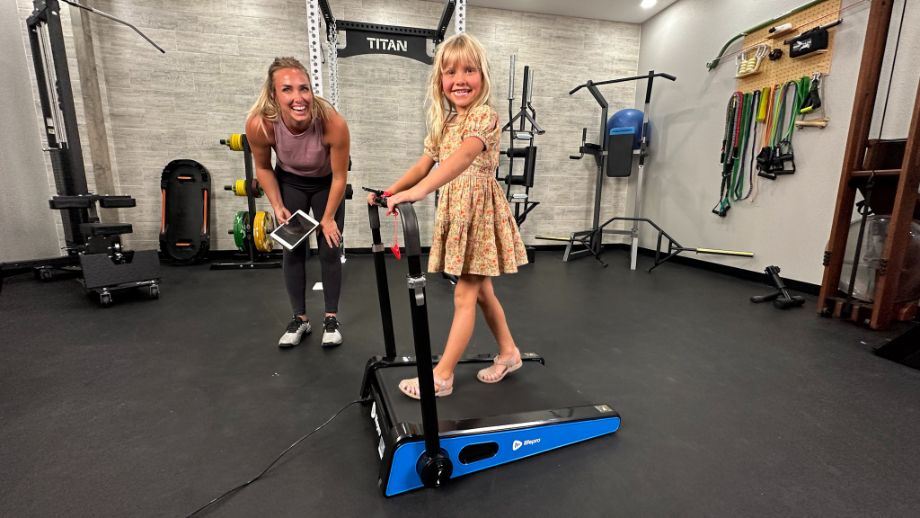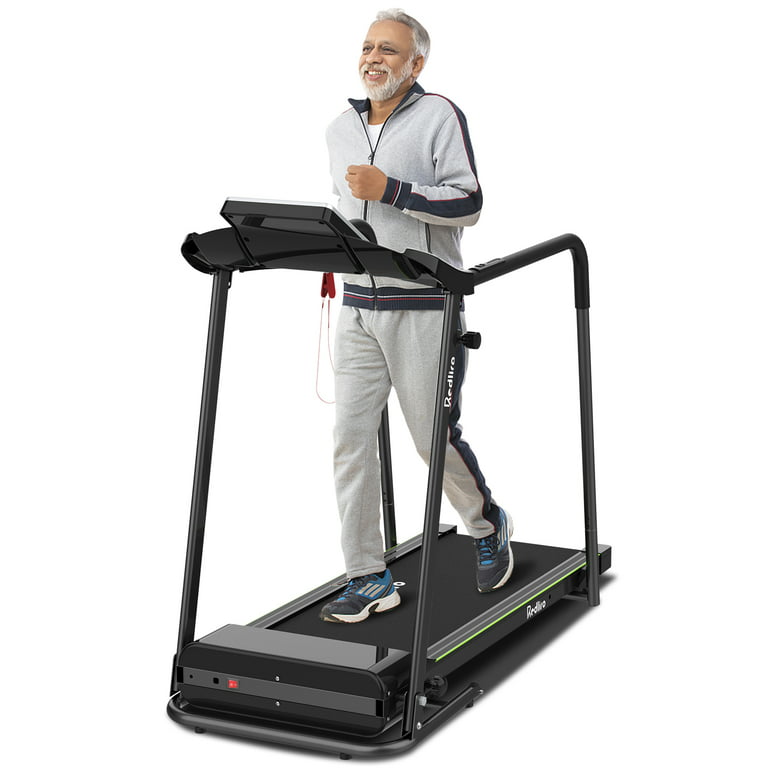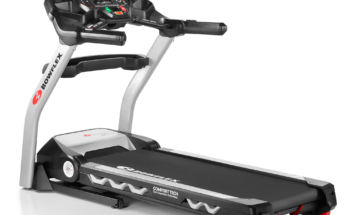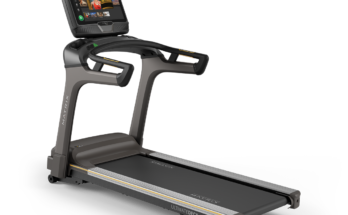Treadmills can be safe for seniors with proper precautions and guidance. They offer adjustable speeds and inclines to match varying fitness levels.
Engaging in regular physical activity is crucial for maintaining health and mobility, especially in older adults. Treadmills provide a convenient option for seniors to stay active, regardless of weather conditions or time of day. They are designed to facilitate walking or running in place, which is an effective form of cardiovascular exercise.
With features like handrails, emergency stop mechanisms, and cushioned decks, treadmills can offer a safer alternative to outdoor walking paths that may pose trip hazards or have uneven surfaces. It’s important for seniors to consult with healthcare providers before starting a treadmill routine, ensuring it aligns with their individual health status and fitness goals. As seniors embark on their treadmill exercises, selecting the right model with appropriate safety features and starting with a gentle program is key to maximizing benefits while minimizing risks.
Treadmills And Senior Fitness
As we age, staying active is crucial. Walking is a fantastic option for seniors, and treadmills offer a safe and convenient way to keep up with cardio fitness. Many older adults find treadmills an excellent tool for maintaining their health. But, safety and ease of use are key concerns. Let’s explore the benefits and considerations of treadmill use for seniors.
Benefits Of Treadmill Exercise For Older Adults
- Improved Cardiovascular Health: Regular treadmill workouts boost heart health.
- Controlled Indoor Environment: No worries about weather or uneven ground.
- Balance and Strength: Walking on a treadmill improves lower body strength and balance.
- Joint Flexibility: Consistent movement helps maintain joint flexibility.
- Customizable Workouts: Treadmill settings adjust to individual fitness levels.
Common Concerns When Seniors Use Treadmills
| Concern | Description | Safety Tips |
|---|---|---|
| Falls | Risk of tripping or losing balance | Use handrails; start slow |
| Overexertion | Exercising too hard or too long | Monitor heart rate; set gradual goals |
| Technological Intimidation | Complex treadmill interfaces | Choose simple models; get a demo |
Seniors can safely enjoy treadmill fitness with the right precautions. Understand individual limits, focus on slow progression, and use treadmills designed with seniors in mind. Overall, treadmills are a versatile tool for older adults looking to enhance their fitness journey.
Safety Features To Look For
When choosing a treadmill for seniors, safety takes priority. Features that promote a secure experience are essential. Seniors need treadmills designed to minimize risks and enhance comfort during exercise.
Low Speed Settings
Starting and ending workouts cautiously is vital for seniors. Look for a treadmill that offers low speed options. These settings allow for a gradual increase and decrease in pace, reducing the risk of falls.
- User-friendly controls make it simple for seniors to adjust speeds.
- Slow starting speeds help avoid sudden jolts.
Emergency Stop Capabilities
Treadmills should come with an emergency stop.
This feature immediately halts treadmill motion in case of a loss of balance or any other emergency. Treadmills often include a safety key that, when removed, stops the belt.
Handrails And Stability
Sturdy handrails offer added support. Pick a treadmill with handrails that are easy to grip and positioned within comfortable reach. Enhanced stability features help prevent slips and falls.
| Feature | Description |
|---|---|
| Extended Handrails | Longer than standard for extra safety |
| Non-slip Side Rails | Textured for a secure foothold |
Pre-workout Considerations
Excitement and health benefits come packed with treadmill workouts for seniors. But safety comes first. Before seniors engage in any treadmill activity, several pre-workout considerations are crucial. These ensure the workout is not only beneficial but also safe.
Medical Clearance For Exercise
Consulting with a healthcare professional is a must before starting a treadmill routine. This step secures a green light for the specific exercises that match the senior’s health status.
- Physical evaluation may reveal any risks.
- Doctors recommend exercises tailored to individual needs.
- Regular check-ups track the progress and tweak routines as necessary.
Proper Footwear And Attire
Selecting appropriate footwear and clothing can significantly reduce accident risks.
- Shoes must offer good traction and cushioning.
- Non-restrictive clothing allows for ample movement.
- Reflective attire increases visibility, enhancing treadmill safety.
Understanding Pre-existing Conditions
Awareness of any pre-existing conditions plays a critical role in creating a safe workout plan.
| Condition | Consideration |
|---|---|
| Heart Disease | Monitor heart rate |
| Arthritis | Low impact routines |
| Balance Issues | Use safety features |
Seniors should tailor workouts to their conditions, focusing on maintaining balance and avoiding strain.

Credit: www.goodrx.com
During Exercise: Safety Practices
Engaging in treadmill workouts can be a beneficial activity for seniors. It improves heart health and keeps joints supple. To ensure these sessions are as safe as possible, certain practices need adherence.
Starting Slow: The Warm-up Phase
Beginning any exercise routine gently prepares the body for more intense activity. It reduces injury risks. Elders should start with slow walks. Gradually, they can increase pace.
- Stretch before stepping on the treadmill.
- Initiate with a 5-minute slow walk.
- Adjust speed incrementally.
Maintaining Proper Posture
Correct posture is crucial for a safe treadmill experience. Slouching or leaning can lead to falls or strains. Erect posture ensures balance and minimizes injury risks. Tips include:
- Keep the head up and eyes forward.
- Align shoulders over hips.
- Lightly grip the handrails for stability, if needed.
- Let arms swing naturally at your side.
Hydration And Breaks
Regular hydration is essential. Dehydration causes dizziness or fatigue, heightening fall risks. Frequent breaks help too. They prevent overexertion. Best practices include:
- Sipping water before, during, and after exercise.
- Pause for rest if you feel tired or dizzy.
- Implement cool-down periods after exercise.
Post-exercise Protocols
Treadmill workouts are a fantastic option for seniors to stay active. Yet, it’s crucial to focus on post-exercise protocols. These ensure that seniors can cool down and track their progress safely.
Cooling Down Safely
Cooling down is as important as the workout session. Seniors must never skip this step. A proper cooldown prevents muscle stiffness and dizziness.
- Walk Slowly: Start by reducing the treadmill speed. Aim for a slow, comfortable pace.
- Stretch Gently: Follow up with stretches. Focus on the legs, arms, and back.
- Hydrate: Drink water to replenish fluids lost during exercise.
Recording Workouts: Tracking Progress And Health
Keeping a record of treadmill activities is vital. It helps seniors monitor their health and celebrates milestones.
Sample RowInclude more rows as necessary| Date | Duration | Distance | Heart Rate | Notes |
|---|---|---|---|---|
| 04/01/2023 | 20 mins | 1.5 miles | 130 bpm | Felt strong |
- Use a Journal: Write down details in a notebook or digital app.
- Monitor Heart Rate: Record heart rate to watch for irregularities.
- Review Regularly: Look back at the records to see improvement over time.

Credit: www.garagegymreviews.com
Coping With Common Treadmill Risks
As seniors strive to stay active, treadmills offer a convenient way to maintain fitness. Yet safety concerns can deter some from stepping onto the belt. Recognizing and managing the risks helps seniors enjoy the benefits of treadmills with confidence. The following strategies address common treadmill hazards, ensuring a safer workout experience.
Dealing With Dizziness And Disorientation
Fight dizziness and disorientation on the treadmill with these tips:
- Start Slow: Ease into your workout to help your body adjust.
- Focus Forward: Keep your eyes ahead to maintain balance.
- Use Handrails: Lightly grip the handrails if you feel unsteady.
- Hydrate: Drink water before and during exercise to prevent dehydration.
Addressing Trips And Falls
Safety is paramount to prevent trips and falls. Seniors should:
- Check Footwear: Wear shoes with good grip.
- Skip Loose Clothing: Choose well-fitted workout gear.
- Maintain the Treadmill: Ensure the machine works well.
- Focus on Form: Walk naturally to keep balance.
Emergency Response Plans
In case of emergencies, a plan should be in place. This includes:
- Emergency Stop: Know how to quickly stop the treadmill.
- Keep a Phone Nearby: Have a way to call for help if needed.
- Inform Others: Let someone know you’re using the treadmill.
- Medical Alert Device: Consider wearing one for immediate assistance.
Incorporating Treadmills Into A Balanced Routine
For seniors, exercise is vital to maintain health and quality of life. Treadmills are a popular choice, offering a safe and controlled environment. But is a treadmill the right fit for every senior’s workout routine? Let’s explore how to balance treadmill use with other exercises for a holistic approach to fitness.
Combining Cardio With Strength And Flexibility
A well-rounded routine includes more than just cardio. It should blend strength training and flexibility exercises like yoga or Pilates. Here’s a quick guide:
- Cardio: Start with a light warm-up, then move to a moderate pace on the treadmill.
- Strength: Use light weights or resistance bands to maintain muscle.
- Flexibility: Finish with stretches or a yoga routine to improve flexibility.
Consulting With Fitness Professionals
Talk to a fitness expert before starting any new exercise plan. A professional can tailor a routine that’s perfect for you. For safety and effectiveness:
- Get a personalized treadmill plan.
- Understand how to use the machine safely.
- Learn other exercises for a balanced routine.
Staying Motivated And Consistent
Consistency is the key to reap the benefits of any exercise routine. Tips to stay on track:
- Set realistic goals.
- Track your progress.
- Find a workout buddy or join a class.

Credit: www.healthline.com
Frequently Asked Questions For Are Treadmills Safe For Seniors
Is Treadmill Good For 70 Year Old?
Treadmills are generally safe for healthy 70-year-olds when used with proper caution and at moderate intensities tailored to individual fitness levels. Always consult a doctor before starting a new exercise regimen.
Who Should Not Use A Treadmill?
Individuals with heart conditions, joint problems, or balance issues should avoid treadmill use. Pregnant women should also consult a doctor before using one. Anyone experiencing chest pain or dizziness should not use a treadmill.
What Is The Age Limit For Treadmill?
There’s no universal age limit for treadmill use, but children under 12 should have adult supervision. Older individuals should consult a doctor before starting a treadmill routine, especially if they have health concerns.
Which Exercise Machine Is Best For Seniors?
Recumbent bikes and elliptical trainers are ideal for seniors. They provide low-impact workouts, minimizing stress on joints while improving cardiovascular health.
Conclusion
Wrapping up, treadmills offer seniors a convenient way to stay active. With safety features and proper use, they’re a viable option for maintaining fitness. Always consult a healthcare professional before starting a new exercise regimen. Embrace a healthier lifestyle with treadmills as a tool for wellness.



